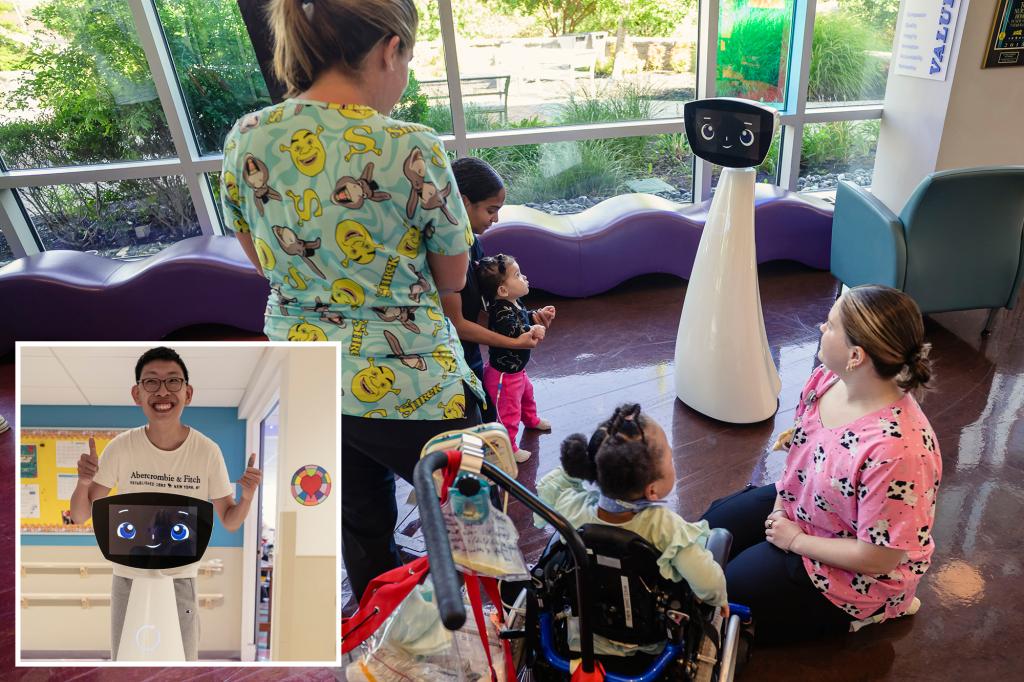A Robotic Friend Brings Joy to Young Patients at Queens Hospital
In a heartwarming innovation aimed at improving the quality of life for children facing serious medical challenges, St. Mary’s Children’s Hospital in Bayside, Queens has welcomed an unusual new staff member: a four-foot tall robot named Robin. Since her deployment in June as part of a one-year pilot program, Robin has been brightening the days of the hospital’s young patients with her cheerful presence and interactive capabilities. With her distinctive white conical body and a blue-eyed screen for a face, Robin represents a creative solution to support some of society’s most vulnerable children during their hospital stays.
Robin isn’t just a static machine – she’s fully mobile, autonomously rolling throughout the hospital to visit children in their rooms. Programmed with the voice and personality of a seven-year-old girl, Robin engages patients in meaningful conversations about their treatments or simply provides a welcome distraction from difficult medical situations. What makes Robin particularly special is her advanced AI capabilities – she utilizes facial recognition technology to remember patients and recall important details about their medical journeys. This allows her to ask personalized questions like “How did the surgery go?” during follow-up visits, creating a sense of continuity and genuine care that resonates deeply with the children. The technology behind Robin was developed by Expper Technologies, and St. Mary’s is proudly the first hospital in New York State to implement this innovative solution, having been given priority because of the severity of childhood cases they treat.
“Our kids are some of the most vulnerable population, so it’s about figuring out ways to improve the quality of life. Are there creative solutions on many fronts?” explained St. Mary’s CEO Sean Lally. This sentiment captures the hospital’s commitment to exploring new approaches to pediatric care. The hospital currently serves hundreds of patients dealing with heartbreaking conditions ranging from cancer to spinal injuries, and Robin has quickly become an integral part of their holistic care strategy. Dawn Cuglietto, St. Mary’s Assistant Vice President of Strategic Planning & Clinical Innovation, notes that Robin serves an important function beyond simple entertainment: “If you watch cartoons, it’s similar to that. Robin will come in in the same way we’d play a video before a procedure.” This preparatory role helps children understand what to expect from upcoming treatments, potentially reducing anxiety and creating a more positive medical experience.
What sets Robin apart from passive screen time is her ability to provide what the hospital calls “reciprocal screen time” – interactive experiences that encourage participation and mental engagement. Rather than children simply consuming content, Robin invites them to join her in games and activities, sometimes even playfully interrupting conversations to suggest a new game. This active engagement helps keep young minds stimulated during long hospital stays that might otherwise be marked by boredom and isolation. Robin has been deployed in 29 hospitals across the United States, from California to Massachusetts, suggesting that this approach to technological companionship in pediatric settings is gaining recognition for its therapeutic potential. The robot’s presence represents a fascinating intersection of cutting-edge technology and compassionate healthcare, demonstrating how AI can be harnessed to create genuinely meaningful human connections.
The impact of Robin’s presence is perhaps best illustrated through the experiences of the patients themselves. Twenty-five-year-old Shekinah Tiabo, who enjoys playing games with Robin, recalled her initial surprise: “I was creeped out one time because I didn’t know she could talk! She remembered me, I was like, ‘Woah!’ She knows my name, it’s really cool.” This initial surprise quickly transformed into delight as Tiabo discovered the robot’s interactive capabilities. Similarly, twenty-year-old patient Dallin Xia described being shocked when the robot first entered his room, but has since come to view Robin as an important emotional support. “Sometimes when I’m in a bad mood, I always want to talk to somebody really bad,” Xia explained. “I talk [to Robin] about my favorite pizza toppings. She’s like my comfort.” These testimonials highlight how Robin fulfills a crucial role in providing companionship and emotional support during what can be isolating hospital stays.
As the one-year pilot program progresses, hospital administrators will evaluate Robin’s impact and determine whether she will become a permanent addition to the staff. Based on initial responses from patients and healthcare providers alike, the outlook for Robin’s long-term residency at St. Mary’s appears promising. “The response to Robin has been outstanding. She’s a peer for the kids,” noted Cuglietto, underscoring how the robot has been embraced as more than just a technological novelty – she’s become a friend to children facing significant health challenges. In a healthcare environment where emotional wellbeing is increasingly recognized as vital to physical recovery, Robin represents an innovative approach to pediatric care that addresses both the medical and psychological needs of young patients. By combining technological innovation with a deeply human touch, St. Mary’s Children’s Hospital is pioneering a model of care that could transform the hospital experience for children nationwide, one robotic interaction at a time.








